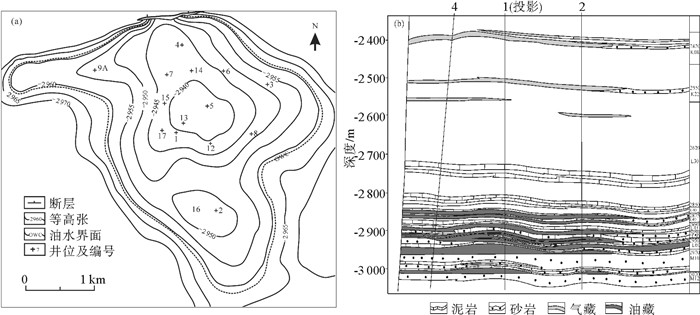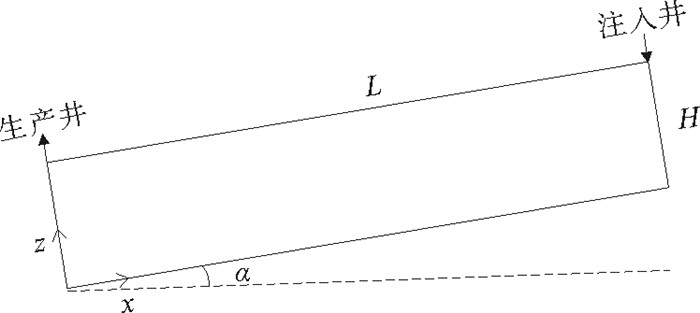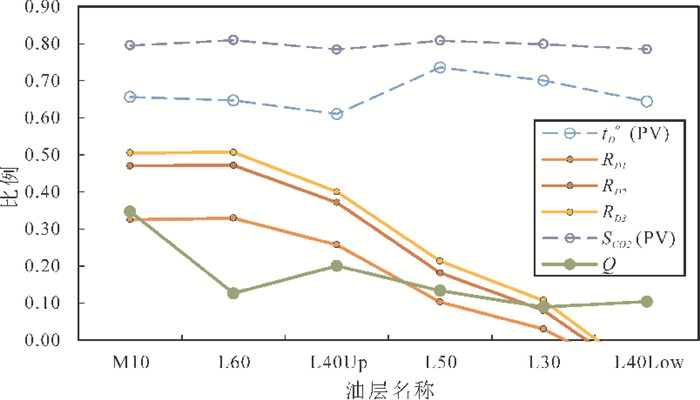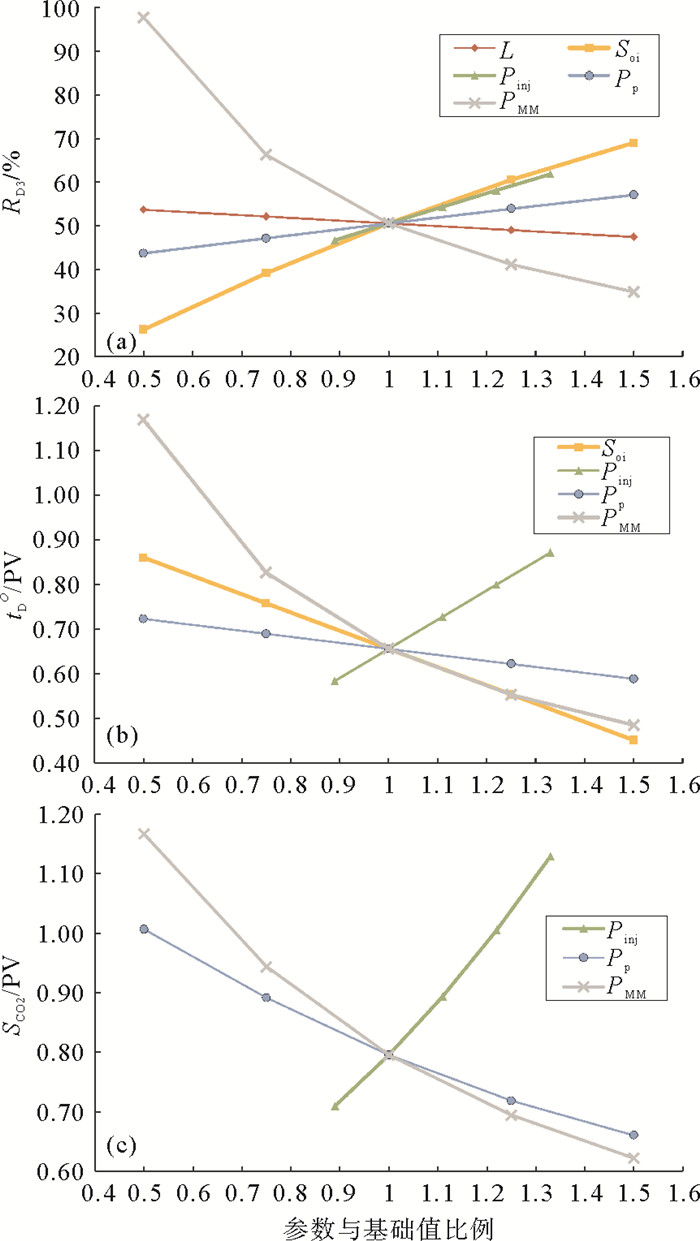QUICK ASSESSMENT OF CO2-EOR AND CO2 SEQUESTRATION POTENTIAL IN HUIZHOU21-1 OILFIELD, PEARL RIVER MOUTH BASIN,
-
摘要:
广东省是二氧化碳(CO2)排放大省,CO2大型排源集中于南海北部沿岸,与珠江口盆地大型油气田构造形成良好源汇匹配关系,因此, 珠江口盆地油气田的CO2驱提高采收率(EOR)和碳封存潜力与适宜性对于广东省低碳发展具有重要意义。采用UT快速评价模型,对珠江口盆地惠州21-1油田的主要油层开展了油层级别的CO2-EOR和碳封存潜力初步评价,结果表明:①惠州21-1油田的6个主要油层中,M10与L60两个层具有最高的采收率(51%),其次为L40Up层(40%),这3个层的突破时间(tD0)也较短,驱油条件优于其他层。各层CO2封存量(SCO2)约0.8PV (PV为孔隙体积),差别不大。结合油藏地质条件综合分析认为,M10层的CO2-EOR和碳封存潜力将是各层中最高的。②参数敏感性分析表明,注入开始时含油饱和度(Soi)和注入压力(Pinj)对采收率影响较大,变化幅度可达45%;tD0和SCO2受(Pinj)影响较大,且SCO2对于压力条件比tD0敏感;最小混相压力(PMM)对评价结果的影响呈非线性。因此,当油田Soi和PMM已确定时,要取得较好的采收率和SCO2封存效果,则主要通过适当提高注入压力来实现。
Abstract:Guangdong Province is one of the biggest CO2 emitters in China. Large CO2 emission sites are mainly distributed along the coast, close to the potential offshore geologic storage sites in the Pearl River Mouth Basin (PRMB). Therefore, it is important for low-carbon economic development in Guangdong Province to assess the potential and feasibility of offshore CO2-Enhanced Oil Recovery (EOR) and carbon storage. Using a quickly screening model for CO2 flooding and storage, the potential of CO2-EOR and storage in Huizhou (HZ) 21-1 oilfield are assessed in this study. The aim is to quickly evaluate CO2-EOR and CO2 storage candidates in 6 oil reservoirs of the HZ21-1 oilfield. The quick-look assessments indicate that: (1) M10, L60 and L40Up would be the more promising reservoirs with higher dimensionless recovery factor (51%, 51% and 40% respectively) and shorter breakthrough time than others such as L50, L30 and L40Low; All of these six reservoirs would approximately store 0.8PV (Pore Volume) of CO2; Comprehensively considering the Original Oil In Place (OOIP) and reservoir properties of those more promising reservoirs, M10 would be the most suitable site for CO2-EOR and CO2storage; (2) In sensitivity analysis, all factors except minimum miscible pressure would have an linear impact on reservoir behavior, and initial oil saturation at the beginning of CO2 injection and injection pressure would significantly affect oil recovery, while CO2 injection pressure would affect breakthrough time and potential on dimensionless CO2 storage. CO2 storage capacity is more sensitive than breakthrough time regarding injection pressure. Hence in general, while initial oil saturation and minimum miscible pressure are constant, higher CO2injection pressure may increase EOR and carbon storage efficiency.
-
Key words:
- quick screening model /
- CO2-EOR /
- CO2 geological sequestration /
- breakthrough time /
- HZ21-1 oilfield
-

-
图 2 惠州21-1油田M10层含油顶面构造(a)和南北向剖面(b) (据文献[10])
Figure 2.
图 3 UT快速评价基础模型示意图(据文献[13])
Figure 3.
表 1 UT快速评价模型的原油成分(据文献[13])
Table 1. Oil components of UT quick screening model (from reference [13])
成分 摩尔分数 CO2 0.019 2 C1 0.069 3 C2-C3 0.174 2 C4-C6 0.194 4 C7-C16 0.313 8 C17-C29 0.154 9 C30+ 0.074 2 表 2 UT快速评价法基础模型输入、输出参数的含义和公式(据文献[13])
Table 2. Input and output parameters of UT quick screening model (from reference [13])
符号 含义 公式 关键参数 输入参数 RL 储层有效长径比 $ {R_L}{\rm{ = }}\frac{L}{H}\sqrt {\frac{{{k_z}}}{{{k_x}}}} $ √ Nα 储层倾角指数 $ {N_\alpha } = \frac{L}{H}\tan \alpha $ × Mgo (CO2和油的)流度比 $ M_{\rm{g}}^o = \frac{{k_{{\rm{rg}}}^o{\mu _{\rm{o}}}}}{{k_{{\rm{ro}}}^o{\mu _{\rm{g}}}}} $ √ Mwo (水和油的)流度比 $ M_w^o = \frac{{k_{rw}^o{\mu _o}}}{{k_{ro}^o{\mu _w}}} $ × Ngo 浮力指数 $ N_{\rm{g}}^o = \frac{{H\Delta \rho g\cos \alpha }}{{\Delta P}} $ √ PinjD CO2注入压力指数 $ {P_{{\rm{injD}}}} = {P_{{\rm{inj}}}}/{P_{{\rm{MM}}}} $ √ PpD 生产压力指数 $ {P_{{\rm{pD}}}} = {P_{\rm{p}}}/{P_{{\rm{MM}}}} $ √ Soi (CO2注入开始时的)初始原油饱和度 $ {S_{{\rm{oi}}}} $ √ Sorw (相对于水的)残余油饱和度 $ {S_{{\rm{orw}}}} $ √ Sorg (相对于CO2的)残余油饱和度 $ {S_{{\rm{org}}}} $ × 注:参数符号上方的横线表示该参数已被归一化到-1和+1的范围 表 3 输入、输出参数公式涉及符号涵义解释(据文献[13])
Table 3. Parameters used in UT quick screening model (from reference [13])
符号 含义 单位 L 注入井与生产井之间的井间距 m H 储层厚度 m kx 水平渗透率 ×10-3μm2 kz 垂向渗透率 ×10-3μm2 α 地层倾角 Kroo 原油相对渗透率端点值 Krgo CO2相对渗透率端点值 μo 地层油黏度 mPa·s μg CO2黏度 mPa·s Δρ CO2与地层油密度差 g/cm3 g 重力加速度 m/s2 Pinj CO2注入压力 MPa Pp 生产压力 MPa ΔP 注入与生产压力差 MPa PMM 最小混相压力 MPa PV 储层孔隙体积 表 4 HZ21-1油田6个油层的属性参数表
Table 4. Screening model property parameters of 6 oil reservoirs in HZ21-1 Oilfield
参数名称 L30 L40Up L40Low L50 L60 M10 岩石和流体变量 地层厚度H/m 5.9 12.9 3.8 8.3 24 40.2 地层倾角α/o 0 0 0 0 0 0 水平渗透率kx/(×10-3μm2) 271.3 317.3 282.3 192.3 68 205.3 垂向-水平渗透率比kz/kx 0.1 0.1 0.1 0.1 0.1 0.1 地层油密度ρoil/(g/cm3) 0.634 0.655 0.655 0.642 0.647 0.747 CO2密度ρco2/(g/cm3) 0.525 0.524 0.527 0.528 0.531 0.534 地层油黏度μoil/mPa·s 0.32 0.41 0.41 0.36 0.35 0.32 CO2黏度μco2/mPa·s 0.054 0.059 0.06 0.066 0.068 0.07 地层油相对渗透率Kroo 0.6 0.6 0.6 0.6 0.6 0.6 气体相对渗透率Krgo 0.3 0.3 0.3 0.3 0.3 0.3 气驱初始含油饱和度Soi/% 22.7 27.3 25.2 21.2 26.6 25.2 最小混相压力PMM /(MPa)** 22.01 23.04 23.04 22.06 22.33 23.14 工程变量 井间距L/m 400 400 400 400 400 400 注入压力Pinj/MPa 32.15 32.64 32.68 32.87 33.35 33.57 生产压力Pp/MPa 14.29 14.51 14.52 14.61 14.82 14.92 注:储层所处地下深度从左至右依次增加;*参考文献[13]计算;**参考Mungan公式计算,详见正文;其余参数值取自文献[10] 表 5 惠州21-1油层CO2-EOR潜力分析计算结果
Table 5. EOR and CO2 storage potential queuing of oil reservoirs in HZ21-1 Oilfield
油层名称 L30 L40Up L40Low L50 L60 M10 突破时间tD0/PV 0.70 0.61 0.64 0.74 0.65 0.66 采收率RD1 0.03 0.26 -0.11 0.10 0.33 0.33 采收率RD2 0.08 0.37 -0.11 0.18 0.47 0.47 采收率RD3 0.11 0.40 -0.10 0.21 0.51 0.51 地质储量百分比Q 0.09 0.20 0.10 0.13 0.13 0.35 封存量SCO2/PV 0.80 0.78 0.78 0.81 0.81 0.79 排序(按采收率RD3 4 2 5 3 1 1 表 6 M10层输入参数敏感性分析取值范围
Table 6. Sensitivity analysis on the M10 reservoir
L/m L/基础值 Soi/% Soi/基础值 Pinj/MPa Pinj/基础值 Pp/MPa Pp/基础值 PMM/MPa PMM/基础值 200 0.50 12.6 0.50 29.84 0.89 7.46 0.50 11.57 0.50 300 0.75 18.9 0.75 33.57 1.00 11.19 0.75 17.36 0.75 400 1.00 25.2 1.00 37.30 1.11 14.92 1.00 23.14 1.00 500 1.25 31.5 1.25 41.03 1.22 18.65 1.25 28.93 1.25 600 1.50 37.8 1.50 44.76 1.33 22.38 1.50 34.71 1.50 -
[1] 周蒂, 李鹏春, 张翠梅.离岸二氧化碳驱油的国际进展及我国近海潜力初步分析[J].南方能源建设, 2015, 2(3): 1-9. http://www.wanfangdata.com.cn/details/detail.do?_type=perio&id=nfnyjs201503001
[2] 张卫东, 张栋, 田克忠.碳捕集与封存技术的现状与未来[J].中外能源, 2009, 14(11): 7-14. http://www.wanfangdata.com.cn/details/detail.do?_type=perio&id=zwny200911002
[3] 沈平平, 廖新维.二氧化碳地质埋存与提高石油采收率技术[M].北京:石油工业出版社, 2009.
[4] Zhou D, Zhao D Q, Liu Q, et al. The GDCCSR Project promoting regional CCS -readiness in the Guangdong Prov- ince, South China [J]. Energy Procedia, 2013, 37: 7622-7632. doi: 10.1016/j.egypro.2013.06.708
[5] 陈澜, 梁希, 周蒂.发展碳捕集、利用与封存对广东的产业机会[J].南方能源建设, 2014, 1(1): 7-15 http://www.wanfangdata.com.cn/details/detail.do?_type=perio&id=nfnyjs201401003
[6] Zhou D, Liao C P, Li P C, et al. CCS can make fossil-fueled energy clean in Guangdong Province, China [J]. Advanced Materials Research, 2013, 807-809: 783-789. http://www.wanfangdata.com.cn/details/detail.do?_type=perio&id=10.4028/www.scientific.net/AMR.807-809.783
[7] Huang Y, Guo H X, Liao C P, et al. The study on prospect and early opportunities for carbon capture and storage in Guangdong Province, China [J]. Energy Procedia, 2013, 37: 3221-3232. doi: 10.1016/j.egypro.2013.06.209
[8] Zhou D, Zhao Z X, Liao J, et al. A preliminary assessment on CO2 storage capacity in the Pearl River Mouth Basin offshore Guangdong, China [J]. International Journal of Greenhouse Gas Control, 2011, 5(2): 308-317. doi: 10.1016/j.ijggc.2010.09.011
[9] Li P C, Zhou D, Zhang C M, et al. Potential of sub-seafloor CO2 geological storage in Northern South China Sea and its importance for CCS development in South China [J]. Energy Procedia, 2013, 37: 5191-5200. doi: 10.1016/j.egypro.2013.06.435
[10] 《中国油气田开发志》总编纂委员会.中国油气田开发志:南海东部油气区油气田卷[M].北京:石油工业出版社, 2011.
[11] 《中国油气田开发志》总编纂委员会.中国油气田开发志(卷二十七):南海东部油气区卷[M].北京:石油工业出版社, 2011.
[12] 朱伟林, 米立军, 等.中国海域含油气盆地图集[M].北京:石油工业出版社, 2010.
[13] Wood D J. Creating a Quick Screening Model for CO2 Flooding and Storage in Gulf Coast Reservoirs Using Dimensionless Groups [D].Austin: The University of Texas, 2006.
[14] Núez-López V, Holtz M H, Wood D J, et al. Quick-look assessments to identify optimal CO2 EOR storage sites [J]. Environmental Geology, 2008, 54(8): 1695-1706. doi: 10.1007/s00254-007-0944-y
[15] Shook M, Li D C, Lake L W. Scaling immiscible flow through permeable media by inspectional analysis [J]. In Situ, 1992, 16(4): 311-349.
[16] 翟光明, 王善书.中国石油地质志(卷十六):沿海大陆架及毗邻含油气区(下) [M].北京:石油工业出版社, 1992.
[17] Mungan N. Carbon Dioxide Flooding-Fundamentals [J]. Journal of Canadian Petroleum Technology, 1981, 20(1): 131-176. doi: 10.2118/81-01-03
[18] He L P, Shen P P, Liao X W, et al. Study on CO2 EOR and its geological sequestration potential in oil field around Yulin city [J]. Journal of Petroleum Science and Engineering, 2015, 134: 199-204. doi: 10.1016/j.petrol.2015.06.002
-



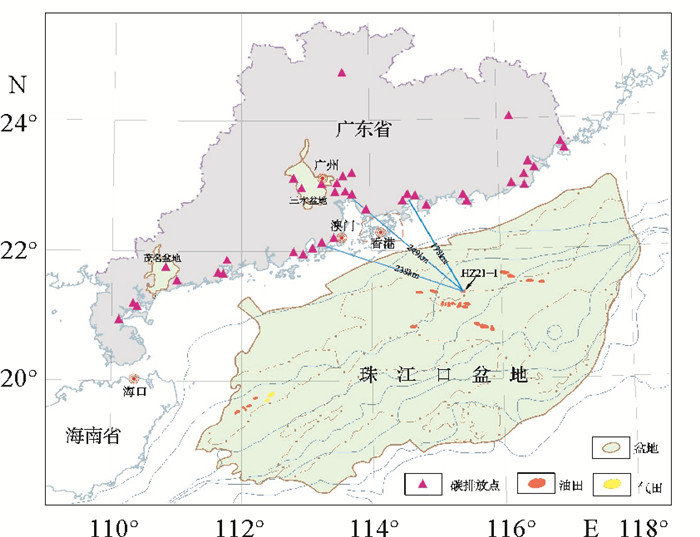
 下载:
下载:
